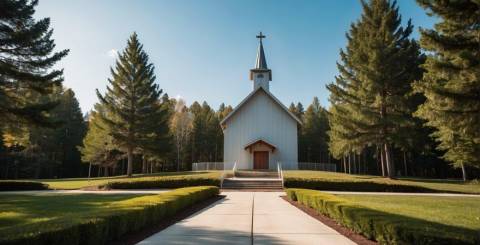Designing Your Steel Church Building: A Guide for Congregations

Steel church buildings offer a practical and efficient solution for congregations looking to build or expand their worship space. With customizable designs and a variety of sizes, steel constructions can accommodate the unique needs of different religious communities. These structures are durable, cost-effective, and can often be erected more quickly than traditional buildings, making them an attractive option for growing congregations.
When planning steel church buildings, it is essential to consider both the spiritual and practical aspects of the building. The interior can be tailored to reflect the values and aesthetics of the community, including choosing colors, materials, and additional features such as wood or stone accents. Outside, the church can make a statement with architectural details or blend harmoniously with its surroundings.
The design process of a steel church is collaborative, involving the congregation's input and the expertise of experienced designers and space planners. This partnership ensures that the final structure not only meets the functional requirements but also becomes a welcoming place of worship and community gathering. With the volatility of steel prices, budgeting for such a project requires careful planning and consideration of economies of scale to optimize the cost savings for the church.
Planning and Design Considerations
When embarking on the journey of creating a steel church building, the congregation must address specific planning and design considerations. These considerations are crucial to ensure that the final structure meets both the spiritual and practical needs of the community.
Community Needs Assessment
A thorough Community Needs Assessment is crucial as it dictates the design and size of the steel church building. One must gather information on:
- Current Membership Size: Understanding the current congregation size helps determine the seating capacity required.
- Projected Growth: Anticipating future growth ensures that the church design accommodates potential expansion needs.
- Programs and Services: Assessing the types of programs and services the church will offer can influence the design of auxiliary spaces, such as classrooms or social halls.
Choosing the Right Location
Selecting a location for the steel church building is a strategic decision that impacts its accessibility and relevance. Considerations include:
- Zoning Laws: Make sure the intended area is zoned for religious use and understand any building restrictions.
- Accessibility: The site should be easily accessible to the congregants, ideally with public transportation options and ample parking.
- Community Impact: Evaluate how the church's location might serve the community’s needs and enhance its outreach potential.
Designing for Functionality and Aesthetics
The design phase should balance functional requirements with aesthetic desires to create a steel church building that is both practical and inspiring. Key design elements include:
- Layout: Optimizing the interior layout to facilitate flow during services and events while ensuring accessibility for all.
- Natural Light: Incorporate large windows or skylights to use natural light, which can reduce electricity costs and enhance the worship space’s ambiance.
- Exterior Features: Select materials for the exterior, like stone cladding, to complement the strength of steel while providing an appealing appearance.
Each step in the planning and design phases is interdependent, requiring careful consideration to ensure the steel church building fully serves its intended purpose for the community it houses.
Construction Fundamentals
This section focuses on the practical aspects of constructing steel church buildings, emphasizing the need for clarity on components, adherence to the construction process, and compliance with safety regulations.
Understanding Steel Building Components
Steel church buildings consist of various essential components that form the structural integrity of the edifice. Key among these are the rigid frames, secondary framing, roof and wall panels, and fasteners. The rigid frame serves as the primary support, typically fabricated from high-strength steel. Secondary framing includes purlins, girts, and eave struts, which provide additional stability. Roof and wall panels not only enclose the building but also contribute to the structure's overall weather resistance. Fasteners are crucial in securing these panels and ensuring that all components remain tightly interlocked.
The Construction Process
The construction of a steel church building follows a streamlined process from inception to completion. Firstly, site preparation involves the clearing, excavation, and leveling of the land. Subsequently, foundation laying takes place to support the weight of the metal structure. Upon erecting the steel frame, the installation of insulation, external cladding, and interior finishes commences. The sequence of steps is vital for the successful assembly of the building, and each stage requires careful planning and execution.
Safety Regulations and Compliance
Safety is paramount throughout the construction of steel church buildings. Builders must adhere to local building codes and OSHA standards to ensure the safety of workers and future occupants. Compliance entails regular inspections, the use of certified materials, and the implementation of safety protocols during construction. It's critical to maintain a work environment that minimizes risks such as falls, structural collapses, or equipment mishaps, thereby safeguarding the integrity of the project and the well-being of all involved.
Cost Analysis and Funding
When considering steel church buildings, congregations need to craft a meticulous budget and explore varied financing options to ensure their project's success.
Budget Planning
The cost of steel church buildings fluctuates based on several determinants such as size, complexity, and regional market variances in materials and labor. Recent estimates suggest planning for $275-$325 per square foot for the complete development cycle, which includes site work, construction, and furnishings. To formulate a realistic budget:
- Itemize all potential expenses.
- Include a contingency fund for unforeseen costs.
- Seek professional cost analysis to aid in budget accuracy.
Financing Options
Funding a steel church building can be a multifaceted process, requiring a blend of finance avenues:
- Loans: Many congregations apply for loans, often utilizing A.I.A. certifiable cost analyses to support their applications.
- Fundraising: A common practice, which may include member donations, fundraising events, or legacy gifts.
- Grants: Investigation into grants from religious institutions or private foundations could be fruitful, although competition may be high.
Maintenance and Sustainability
When congregations choose steel church buildings, they invest in both longevity and environmental stewardship. These structures offer discernible advantages in terms of maintenance and sustainable practices.
Long-term Care
Steel church buildings are designed with durability in mind, leading to less frequent and often less costly maintenance over time. Factors such as:
- Corrosion Resistance: Steel's innate resistance to rust and corrosion is enhanced by protective coatings, which extend the lifespan of the building components.
- Structural Warranties: Many suppliers offer extensive warranties for structural integrity, paint finishes, and roofing materials, some extending up to 50 years.
Regular maintenance tasks typically include:
- Inspecting for and promptly repairing any damage to coatings or structural elements.
- Cleaning gutters and downspouts to prevent water damage.
- Checking for any signs of moisture infiltration or condensation which could affect interior materials.
Environmental Considerations
The choice of steel for church construction reflects a commitment to sustainability. Features that contribute to steel church buildings being environmentally friendly include:
- Recyclability: Steel is 100% recyclable, which means it can be reused without loss of quality, reducing the demand for new materials.
- Energy Efficiency: They can be designed with energy-saving features like high-performance insulation and cool roofing to minimize energy consumption for heating and cooling.
Environmental impacts are further mitigated through:
- Sustainable building practices, which include minimizing on-site waste during construction.
- Opportunities for integrating renewable energy sources, such as solar panels, compatible with steel structures.
Similar Articles
Discover the best lease accounting software for your business needs with our expert guide. Compare features, pricing, and make the right choice today!
Our world is constantly changing, and that much has been for everyone to see.
Discover how AI phone assistants revolutionize reservations! Explore streamlined booking processes & enhanced customer experiences. Dive in now!
Discover the latest advancements in night vision technology with our comprehensive guide to the leading manufacturers in 2024. Explore now!
In today's technologically advanced landscape, understanding heat distribution is critical for enhancing efficiency and safety across various sectors. Infrared thermography, a pivotal imaging technique, has revolutionized how professionals view and analyze thermal performance.
In this digital age, there are many options available for marketing, but the one that stands out as one that can transform the marketing realm is programmatic connected TV (CTV). The programmatic CTV approach for advertising shows the changing trend in how brands would like to connect with their audience.
PHP has a dominant market position, with over 79% of websites powered to some degree. Developers majorly utilize organized and leveled PHP basic functions, known as PHP frameworks, to create flexible output.
The nonstop hum of machines around us, from the humongous industrial complexes to the processors within the gadgets, shapes our everyday lives. These mechanical advancements have become essential, driving everything from fundamental necessities to our vehicles, airplanes, and so forth.
New methods of managing a Pilate business are transforming the way studios operate. It simplifies routine tasks and helps fitness businesses to grow and facilitate their customers in various ways.









